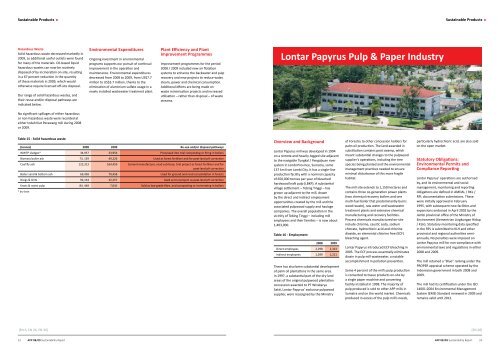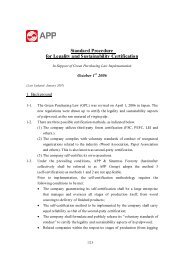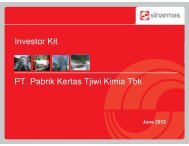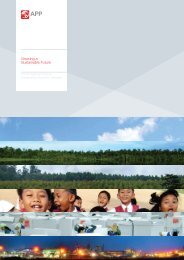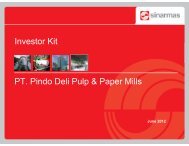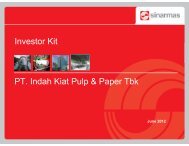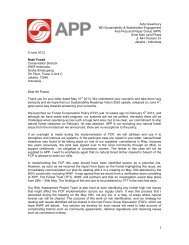APP Sustainability Report 2008-2009 - Asia Pulp and Paper
APP Sustainability Report 2008-2009 - Asia Pulp and Paper
APP Sustainability Report 2008-2009 - Asia Pulp and Paper
You also want an ePaper? Increase the reach of your titles
YUMPU automatically turns print PDFs into web optimized ePapers that Google loves.
Sustainable Products<br />
Sustainable Products<br />
Hazardous Waste<br />
Solid hazardous waste decreased markedly in<br />
<strong>2009</strong>, as additional useful outlets were found<br />
for many of the materials. Oil-based liquid<br />
hazardous wastes can now be routinely<br />
disposed of by incineration on-site, resulting<br />
in a 67 percent reduction in the quantity<br />
of these materials in <strong>2009</strong>, which would<br />
otherwise require licensed off-site disposal.<br />
Our range of solid hazardous wastes, <strong>and</strong><br />
their reuse <strong>and</strong>/or disposal pathways are<br />
indicated below.<br />
Environmental Expenditures<br />
Ongoing investment in environmental<br />
programs supports our pursuit of continual<br />
improvement in the operation <strong>and</strong><br />
maintenance. Environmental expenditures<br />
decreased from <strong>2008</strong> to <strong>2009</strong>, from US$7.7<br />
million to US$3.7 million, thanks to the<br />
elimination of aluminium sulfate usage in a<br />
newly installed wastewater treatment plant.<br />
Plant Efficiency <strong>and</strong> Plant<br />
Improvement Programmes<br />
Improvement programmes for the period<br />
<strong>2008</strong> / <strong>2009</strong> included new air flotation<br />
systems to enhance the backwater <strong>and</strong> pulp<br />
recovery <strong>and</strong> new projects to reduce water,<br />
steam, power <strong>and</strong> chemical consumption.<br />
Additional efforts are being made on<br />
waste minimisation projects <strong>and</strong> increased<br />
utilisation – rather than disposal – of waste<br />
streams.<br />
Lontar Papyrus <strong>Pulp</strong> & <strong>Paper</strong> Industry<br />
No significant spillages of either hazardous<br />
or non-hazardous waste were recorded at<br />
either Indah Kiat Perawang mill during <strong>2008</strong><br />
or <strong>2009</strong>.<br />
Table 15 - Solid hazardous waste<br />
(tonnes) <strong>2008</strong> <strong>2009</strong> Re-use <strong>and</strong>/or disposal pathways<br />
WWTP sludges* 34,957 33,956 Processed into trial composting or firing in boilers<br />
Biomass boiler ash 73, 139 49,226 Used as forest fertiliser <strong>and</strong> for peat-l<strong>and</strong> pH correction<br />
Coal fly ash 122,313 164,459 Cement manufacture, road sub-base, trial project as forest fertiliser <strong>and</strong> for<br />
peat-l<strong>and</strong> pH correction<br />
Boiler s<strong>and</strong> & bottom ash 69,458 70,458 Used for ground <strong>and</strong> road consolidation in forests<br />
Dregs & Grits 92,134 32,257 Used as trial project as peat-l<strong>and</strong> pH correction<br />
Knots & reject pulp 84, 448 7,041 Sold as low-grade fibre, <strong>and</strong> composting or incinerating in boilers<br />
* dry base<br />
Overview <strong>and</strong> Background<br />
Lontar Papyrus mill was developed in 1994<br />
on a remote <strong>and</strong> heavily-logged site adjacent<br />
to the navigable Tungkal / Pengabuan river<br />
system in Jambi Province, Sumatra, some<br />
137 km from Jambi City. It has a single-line<br />
production facility with a nominal capacity<br />
of 650,000 tonnes per year of bleached<br />
hardwood kraft pulp (LBKP). A substantial<br />
village settlement – Tebing Tinggi – has<br />
grown up adjacent to the mill, drawn<br />
by the direct <strong>and</strong> indirect employment<br />
opportunities created by the mill <strong>and</strong> the<br />
associated pulpwood supply <strong>and</strong> haulage<br />
companies. The overall population in the<br />
vicinity of Tebing Tinggi – including mill<br />
employees <strong>and</strong> their families – is now about<br />
1,403,000.<br />
Table 16 - Employment<br />
<strong>2008</strong> <strong>2009</strong><br />
Direct employees 2,298 2,323<br />
Indirect employees 1,399 1,211<br />
There has also been substantial development<br />
of palm oil plantations in the same area.<br />
In 1997, a substantial part of the dry l<strong>and</strong><br />
areas of the original pulpwood plantation<br />
concession awarded to PT Wirakarya<br />
Sakti, Lontar Papyrus’ exclusive pulpwood<br />
supplier, were reassigned by the Ministry<br />
of Forestry to other concession holders for<br />
palm oil production. The l<strong>and</strong> awarded in<br />
substitution contains peat swamp, which<br />
meant substantial changes to the pulpwood<br />
supplier’s operations, including the tree<br />
species being planted <strong>and</strong> the environmental<br />
management practices needed to ensure<br />
minimal disturbance of this more fragile<br />
habitat.<br />
The mill site extends to 1,150 hectares <strong>and</strong><br />
contains three co-generation power plants<br />
(two chemical recovery boilers <strong>and</strong> one<br />
multi-fuel boiler that predominantly burns<br />
wood-waste), raw water <strong>and</strong> wastewater<br />
treatment plants <strong>and</strong> extensive chemical<br />
manufacturing <strong>and</strong> recovery facilities.<br />
Process chemicals manufactured on-site<br />
include chlorine, caustic soda, sodium<br />
chlorate, hydrochloric acid <strong>and</strong> chlorine<br />
dioxide, an elemental chlorine free (ECF)<br />
bleaching agent.<br />
Lontar Papyrus introduced ECF bleaching in<br />
2005. The ECF process essentially eliminates<br />
dioxin in pulp mill wastewater, a notable<br />
accomplishment in pollution prevention.<br />
Some 4 percent of the mill’s pulp production<br />
is converted to tissue products on-site by<br />
a single paper machine <strong>and</strong> converting<br />
facility installed in 1998. The majority of<br />
pulp produced is sold to other <strong>APP</strong> mills in<br />
Sumatra <strong>and</strong> on the world market. Chemicals<br />
produced in excess of the pulp mill’s needs,<br />
particularly hydrochloric acid, are also sold<br />
on the open market.<br />
Statutory Obligations:<br />
Environmental Permits <strong>and</strong><br />
Compliance <strong>Report</strong>ing<br />
Lontar Papyrus’ operations are authorised<br />
by, <strong>and</strong> its environmental <strong>and</strong> social<br />
management, monitoring <strong>and</strong> reporting<br />
obligations are defined in AMDAL / RKL /<br />
RPL documentation submissions. These<br />
were initially approved in February<br />
1995, with subsequent new facilities <strong>and</strong><br />
expansions endorsed in April 2002 by the<br />
Jambi provincial office of the Ministry of<br />
Environment (Kementrian Lingkungan Hidup<br />
/ KLH). Statutory monitoring data specified<br />
in the RPL is submitted to KLH <strong>and</strong> other<br />
provincial <strong>and</strong> regional authorities semiannually.<br />
No penalties were imposed on<br />
Lontar Papyrus mill for non-compliance with<br />
environmental laws <strong>and</strong> regulations in either<br />
<strong>2008</strong> <strong>and</strong> <strong>2009</strong>.<br />
The mill retained a “Blue” ranking under the<br />
PROPER appraisal scheme operated by the<br />
Indonesian government in both <strong>2008</strong> <strong>and</strong><br />
<strong>2009</strong>.<br />
The mill had its certification under the ISO<br />
14001:2004 Environmental Management<br />
System (EMS) St<strong>and</strong>ard renewed in <strong>2009</strong> <strong>and</strong><br />
remains valid until 2012.<br />
[EN 6, EN 26, EN 30]<br />
[EN 28]<br />
32 <strong>APP</strong> 08/09 <strong>Sustainability</strong> <strong>Report</strong> <strong>APP</strong> 08/09 <strong>Sustainability</strong> <strong>Report</strong> 33


